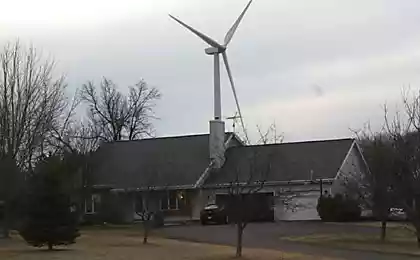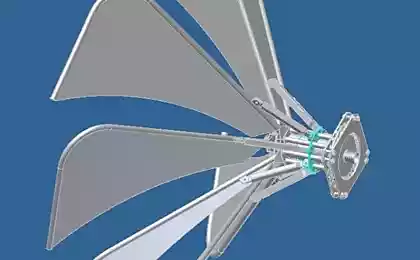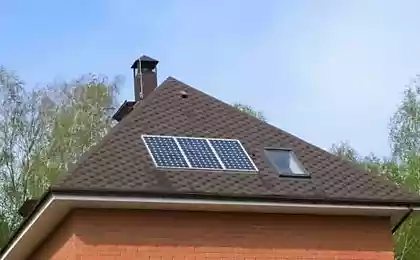541
Improving the efficiency of low power wind turbines

Large-scale extraction of energy resources of the earth leads to its gradual depletion, forcing humanity to revert to renewable sources of energy. A special place among renewable energy sources is wind energy. For Ukraine, until recently, this area of energy remained a priority, but now she begins to develop and is becoming more widespread.
Among vetrogeneratory units (WU) low-power, up to 5-10 kW, according to their purpose and the load it is possible to allocate installation, working offline with the drive or on the grid. In most installations, the power extracted from the wind generator (VG) is fixed at some constant level, which is set usually by the current limit level of the installation. WU if the generated energy is less than this level, then no conversion occurs and the unit is in standby mode.
Due to the fact that the area of permanent winds can be quite low (3-4 m/s), the level of a given selected power set at a level to allow installation in the lower level of the range of variation of wind speed. It provides near-continuous health WOO, but lowers its use at higher speeds of the winds, when you can potentially give more power than the set level.
On the other hand, increasing levels of output power can be limited to the maximum current of the charge storage elements, and also lead to underutilization of the installation at low wind speed.
To improve the efficient use of the energy generated is proposed to use a control system of a Converter with variable selected output power, depends on how much power can provide WU at the moment. The proposed system applies to WU without mechanical system of speed stabilization, working directly on the network.
To convert the energy used WU with a power of 5 kW. The range of wind speeds under which it is expected the efficiency of the installation, 3-20 m/s. in this range of wind speeds the energy that can give VG varies in the range of 200-5000 watts, with range of speed of rotation of the shaft SH 50-650 rpm./min Network, which operates the installation, is a three-phase AC voltage 380 V frequency. Before the control system task is to transmit to the network the same capacity, which at the moment can provide the wind turbine and thus provide for maximum utilization of WU. Functional diagram of the system shown in figure 1.
Figure 1. Functional diagram of the system WU low power 5-10 kW without mechanical stabilization of the speed of rotation running parallel to the network
It includes the actual generator, which is brushless electric machine with permanent magnets, voltage regulator and inverter, the slave network. To the input of the inverter is fixed by the magnitude of the voltage Ist = 250 and set on output to the network power RZ. At the output of the inverter connected to three-phase network and reverses the power to the grid.
For normal operation of the inverter at the input is necessary to maintain constant the magnitude of the voltage with a precision of 5%. The voltage regulator should provide a constant output voltage when changing in a wide range of input voltage. In General, when the above range of the winds, the input voltage of the IG can vary in the range 70-300 V. At the input of the generator, the rotation speed of the generator shaft wг betray him from the shaft installation, in which the blade, through the multiplexer.
In this the output voltage of the stabilizer should provide the ability to increase and decrease the input voltage. The maximum fold increase in the input voltage will be about 4, and lower — not more than 0.8. If the input voltage exceeds the specified threshold, then the stabilizer and the entire plant is turned off and go into standby mode.
The power part of the stabilizer with these requirements performed by a transformerless circuit with a common inductance. Functional scheme of the power part of the voltage regulator for the WU is shown in figure 2.
Figure 2. Functional diagram of the power part of the stabilizer WU
The scheme can operate in two modes: enhancement mode when a voltage at the input of the stabilizer is less than the voltage stabilizing and lowering, when the voltage at the input of the stabilizer is greater than the voltage stabilization. In the first mode, the key K1 closed and the key K2 is working with a certain duty cycle, a so-called booster circuit. Thus, when the key K2 is closed, the voltage at the input of the stabilizer is applied to the inductor L1, and current flows. When this stored energy in the inductance. When the key K2 opens, in the inductance occurs EMF of self-induction, which consists of the voltage input of the stabilizer, and the output of the stabilizer is obtained a voltage higher than the voltage at the input of the stabilizer.
In the second case, when the circuit operates in the mode of reduction, the key K2 open and the switch SW1 operates with a certain duty cycle, thereby forming a so-called chopper scheme of reduction. The inductance together with the output capacity C2 plays the role of filter. The value of the duty cycle with which the keys work in each of the modes is determined by the control scheme, the switching frequency of the keys 20 kHz. The principles of operation of pulsed devices, based on this methodology, read more outlined in the article "Electric drive according to the scheme: switching power supply step down type – engine" (Shpigler L. A.).
To determine the energy performance WU stabilizer appreciates the input voltage and in accordance with its programmed function that represents the dependence of the permissible output power from its voltage at a given geometry VU (value of the blade angle of attack), produces job output by the inverter to the power network. Together with the formation of the task for inverter stabilizer generates the motor current not to exceed the maximum current that can give the generator to maximize the use of installation, but not to overload it, which will inevitably lead to reduce the speed of rotation of the installation and its final stop. Block diagram of the system shown in figure 3.
Figure 3. Block diagram of the control system WU
The control system is based on the principle of slave control with proportional — integral controllers of voltage and current (RN and RT). The output signal from the voltage regulator is supplied to the node of the dependent current limit (ZT), which forms the law of current limiting in accordance with its programmed function. The power part of the stabilizer (ST) is represented by the inertial element, and an inverter, acting as a load element variable internal resistance, which also varies in accordance with the mission, formed element (ZN). Inside this link of the inherent load characteristics of the installation; it can help to determine the amount of power that can give the setting in each mode WOO and the network. Typical load characteristics of the VU is described in the article "Renewable energy sources" (Twidell J., A. Weir).
The simulation results for the block diagram system shown in figure 3, shown in figure 4.
Figure 4. The simulation results of the system:
1 is a graph of the input voltage of the stabilizer, the peak on the graph corresponds to a wind gust;
2 — a graph of the output voltage of the stabilizer. WU;
3 — graphs of the current stabilizer
From the obtained graphs we can conclude about the functionality of the proposed system and its effectiveness under varying wind speed. Testing of system inherent characteristics, is almost 100%, it can be seen from matching jobs to the current and actual current of the system, and the instability of the output voltage of the stabilizer is less than 3%.
In the proposed structural scheme of the system and stabilizer have been designed and created a prototype of the stabilizer, and also performed its tests with a generator of 5 kW capacity and the slave network inverter German company Test&Power Solutions power 6 kW. The system of stabilization of the output voltage of the stabilizer was created digitally using microcontrollers Texas Instruments.
The results of experimental research of the system, representing the dependence of the power output to the network by inverter, the speed of rotation of the shaft SH, as shown in figure 5.
Figure 5. The results of an experimental study of the system WOO
Experimental results confirm the theoretical data obtained by simulation of the system structure, and show its effectiveness in a wide range of speeds of rotation of the shaft of the generator, and hence the speed of the wind flow.
After conducting experimental studies of a prototype regulator was an experimental series of stabilizers in the amount of 10 PCs for low-power WU with the capacity of 5 kW. Smotrov E. A., Vershinin D. V., M. V. Guly
Source: alternativenergy.ru























